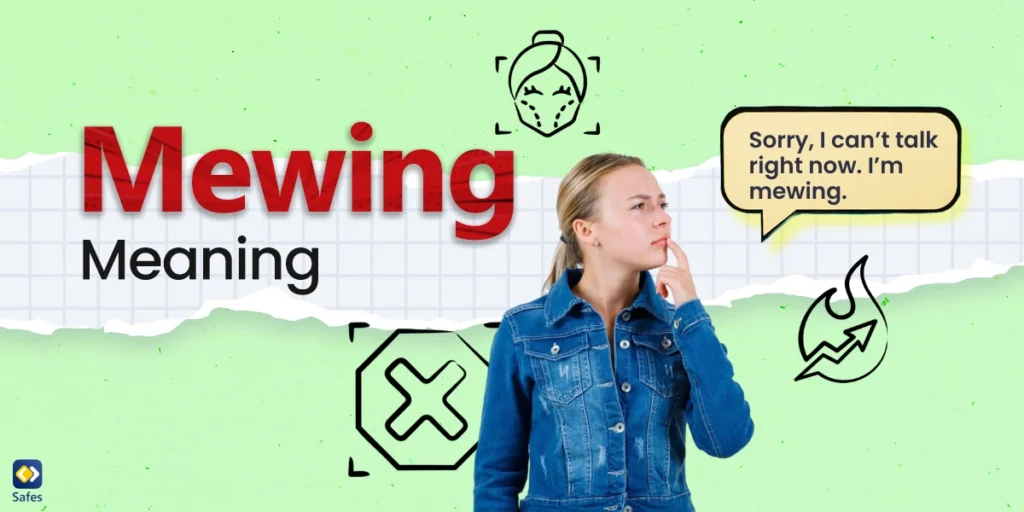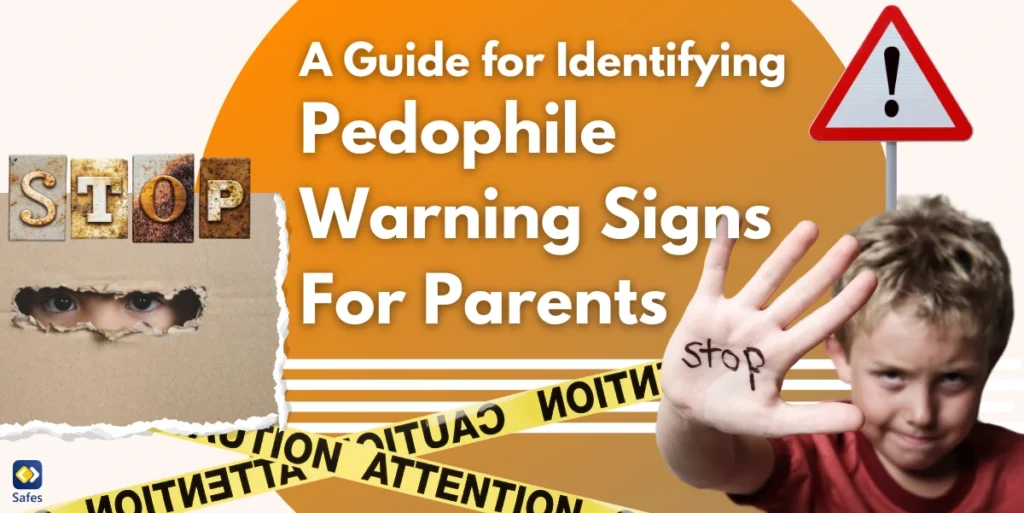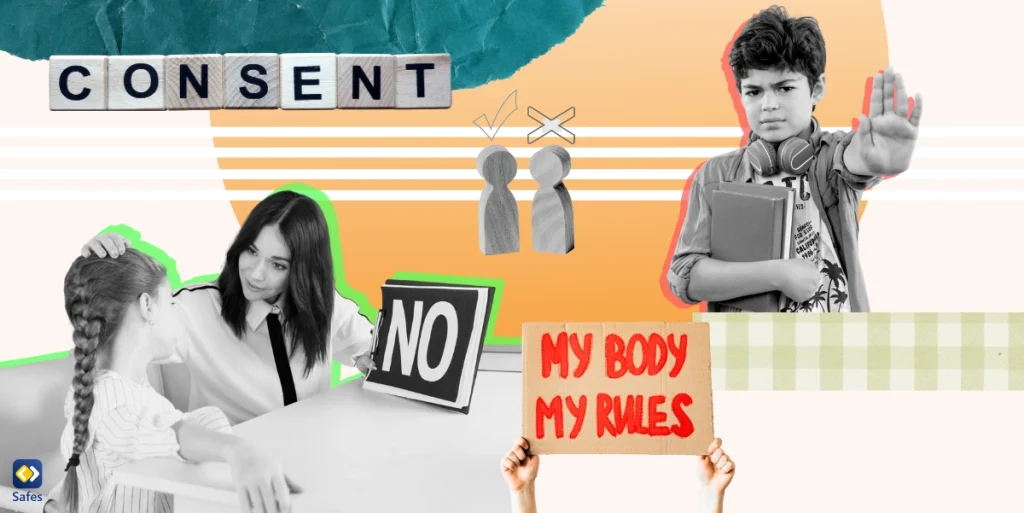Just like every teenager is known for having their phase of not wanting to talk to their parents, teachers, or any adults for that matter, Gen Alpha has found their own way to disengage. From “talk to the hand” to “whatever,” teens now have their own method of avoiding conversation. If you’ve seen the gesture of shushing and pointing toward their jaw, or if you’ve come across a text that says, “I’m mewing, can’t talk,” you’ve probably wondered, “What is mewing?” Well, you’re not alone. In this blog, we’ll break down the meaning of “mewing,” its rise in popularity, and everything you need to know about it.
Download and Start Your Free Trial of the Safes Parental Control App
What Is Mewing in Slang?
“Mewing” originally referred to a facial exercise that involves positioning the tongue against the roof of the mouth in an effort to improve jawline structure and overall facial appearance. It’s often associated with the idea of reshaping the face by adopting a specific posture or exercise. The term has gained popularity on social media, particularly among teens and young adults, as part of the self-improvement and beauty culture. However, a new twist has emerged, with children using “mewing” as an excuse to avoid speaking or answering questions. They place a finger to their lips and gesture towards their jawline, signaling that they are “mewing” and thus unable to talk.

How is Mewing Used in Real Digital Interactions?
The slang term “mewing” has evolved beyond its original meaning of a facial exercise for jawline enhancement. Today, kids and teens use it in various ways in texts, social media, and gaming chats. Here are some examples of how it appears in real digital interactions:
Example 1 (Text Message):
- “Sorry, I can’t talk right now. I’m mewing.”
- Tone: Playful and lighthearted.
- In this text, the teen uses “mewing” as an excuse for not engaging in conversation, making the term a humorous way to avoid talking.
Example 2 (TikTok Post):
- “Just finished my mewing session… still waiting for that jawline transformation 😎 #Mewing #NoResultsYet”
- Tone: Sarcastic and self-deprecating.
- On TikTok, teens often use “mewing” in a playful way, poking fun at the trend of reshaping their jawlines, while embracing the humor of not seeing immediate results.
Example 3 (Gaming Chat):
- “Bro, stop mewing and help us win this round! 😂”
- Tone: Sarcastic and teasing.
- In gaming chats, “mewing” is used to tease someone who might be distracted by vanity or self-improvement routines, lightheartedly calling them out for not focusing on the game.
Example 4 (Snapchat Story):
- “Can’t talk right now, I’m mewing. Don’t bother me 😎”
- Tone: Casual and dismissive.
- On Snapchat, teens often use “mewing” in private messages or group chats to playfully ignore others, signaling that they’re too busy with their own routines to engage.
Platform-Specific Usage
The way “mewing” is used can vary significantly across different platforms, reflecting the unique tone and culture of each space. Here’s how it’s used on popular platforms:
What Does “Mewing” Mean on TikTok?
On TikTok, “mewing” is often part of self-improvement or beauty trend videos, where users document their facial exercises in an exaggerated, humorous way. Hashtags like #Mewing or #JawlineGoals are commonly used in these posts.
What Does “Mewing” Mean on Snapchat?
On Snapchat, “mewing” is typically used casually, often as an excuse to avoid conversation or as part of inside jokes in group chats. Teens might send a Snap saying they’re “mewing” instead of responding to a message, using it to playfully disregard interactions.
What Does “Mewing” Mean on Discord?
In Discord gaming communities, “mewing” is used sarcastically to call out someone who’s distracted when they should be focused on the game. It’s often accompanied by memes or gifs, contributing to the lighthearted and teasing tone typical of gaming chats.
What Does “Mewing” Mean on Instagram?
On Instagram, “mewing” is sometimes used in the context of beauty or fitness influencers sharing their journey of jawline enhancement. Here, it can be more serious, with users documenting their progress in hopes of a transformation. However, it can also be seen in memes or captions where users humorously exaggerate the expected results, blending the trend with Instagram’s aesthetic culture.
Risk Level Indicator (Parent Alert System)
🟡 Yellow – Context matters; can be misused.
For the slang term “mewing,” the risk level would be rated as yellow. While “mewing” refers to a facial exercise aimed at improving jawline appearance, the term can be misused or misinterpreted in certain contexts. For instance, it could become a point of ridicule or body shaming when used excessively, potentially contributing to unrealistic beauty standards.
Additionally, “mewing” is sometimes used dismissively towards adults, as kids and teens may playfully use it as an excuse to avoid talking or engaging with authority figures. This may be harmless in some cases, but it can be a sign of dismissiveness or rudeness if taken too far.
It’s also important to note that there is no scientific research to support the effectiveness of mewing in reshaping the jawline or improving facial features (as mentioned in sources like Medical News Today), so any potential obsession over it could be based on unrealistic expectations. While it may be seen as a fun or trendy activity, parents should be cautious of any harmful preoccupation with beauty standards or body image that might arise from the use of this term.
Trend Tracker: Is It Still Relevant?
As of May 2025, “mewing” is 🔥 Trending among Generation Alpha (those born between 2010 and 2024).
Originally referring to a facial exercise aimed at reshaping the jawline, the term has evolved in Gen Alpha slang to denote a nonverbal gesture indicating a desire to remain silent or avoid interaction. This gesture involves placing a finger to the lips and tracing the jawline, signaling “I don’t want to talk.” The trend has gained significant attention on platforms like TikTok, where teachers have noted its widespread use among students to humorously deflect questions or avoid participation in classroom activities. While some educators find the gesture disruptive, it remains a popular and evolving aspect of Gen Alpha’s digital communication culture.
Online Safety Considerations
While the term “mewing” itself isn’t inherently dangerous, it could be associated with concerning online behaviors if misused. For instance, the term can sometimes be linked to body shaming or unrealistic beauty expectations, which could contribute to negative self-image or low self-esteem in young people. It’s important to be aware that the trend may lead to peer pressure or teasing among kids and teens, especially if someone feels the need to constantly compare themselves to others’ perceived jawline or facial features. This could escalate into cyberbullying, particularly on platforms like TikTok or Instagram, where appearance-driven content is frequently shared.
Quick Advice for Parents
- Discuss the term openly: Talk to your kids about “mewing” and its popularity on social media. Ask if they’ve heard about it, and if so, how they feel about it. This opens up a healthy conversation about body image and online trends.
- Encourage critical thinking: Help your kids understand that there’s no scientific evidence to support the effectiveness of “mewing” in reshaping facial features. This can reduce the pressure they might feel to conform to unrealistic beauty ideals.
- Monitor social media habits: Keep an eye on the content your kids are engaging with on platforms like TikTok, Instagram, and Snapchat. If you notice any signs of cyberbullying, body shaming, or excessive preoccupation with appearance, intervene early.
- Use Parental Controls: Consider using parental controls on Android to monitor your child’s social media activities.

How Can Safes Help?
Safes parental control app, is a helpful tool for parents concerned about their children’s digital safety. It allows you to monitor their online activities, including social media, gaming apps, and websites, and block or limit access to harmful content. You can set screen time limits and get detailed reports on your child’s usage, helping you spot potential risks like exposure to body-shaming trends or excessive focus on appearance-related content like “mewing.” With Safes, available on both Android and iOS, you can guide your child through the digital world and promote a safe online experience. Try the free trial today for peace of mind!
Conclusion
While “mewing” might seem like a harmless trend, it’s important for parents to be aware of how their kids are using it. Talk to your child about the term and help them understand its meaning in the context of both self-improvement and the potential for misinterpretation. Encourage them to think critically about beauty trends and be cautious of any negative impacts they may have on their self-esteem. Being involved and keeping open communication with your child is key to ensuring they navigate these online trends safely.
Your Child’s Online Safety Starts Here
Every parent today needs a solution to manage screen time and keep their child safe online.
Without the right tools, digital risks and excessive screen time can impact children's well-being. Safes helps parents set healthy boundaries, monitor activity, and protect kids from online dangers—all with an easy-to-use app.
Take control of your child’s digital world. Learn more about Safes or download the app to start your free trial today!




